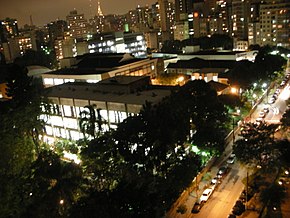| This article needs additional citations for verification. Please help improve this article by adding citations to reliable sources. Unsourced material may be challenged and removed. Find sources: "Mackenzie Presbyterian University" – news · newspapers · books · scholar · JSTOR (June 2023) (Learn how and when to remove this message) |
 Mackenzie Presbyterian University Mackenzie Presbyterian University | |
| Motto | Tradição e Pioneirismo na Educação (Portuguese) |
|---|---|
| Motto in English | Tradition and Pioneering in Education |
| Type | Private, non-profit |
| Established | 1870; 154 years ago (1870), 1952; 72 years ago (1952) as a university |
| Affiliation | Presbyterian Church of Brazil |
| Chancellor | The Rev. Dr. Davi Charles Gomes |
| Rector | Dr. Benedito Aguiar Neto |
| Vice rector | Dr. Marcel Mendes |
| Students | 40,000+ |
| Location | São Paulo (Campus Higienópolis), Barueri (Campus Alphaville), Campinas, Brazil |
| Colours | Red Black |
| Website | mackenzie.br |
Mackenzie Presbyterian University (Portuguese: Universidade Presbiteriana Mackenzie) is a private university in São Paulo, Brazil.
The Mackenzie Presbyterian University is an institution of higher learning that has a strong tradition and history in Brazil. It has campuses for undergraduate and postgraduate studies in São Paulo (Campus Higienópolis), Campinas, Barueri (Campus Alphaville), Brasília, Curitiba and Rio de Janeiro.
Founded in 1870 as the American School, Mackenzie is one of the oldest institutions of higher education in Brazil. The university is regarded nationally and internationally as a center of excellence having graduated numerous important names in Brazilian history.
History

In 1870, the American Presbyterian missionary Rev. George Whitehill Chamberlain and his wife Mary Annesley founded a private grammar school inside their home. The classes were held in their living room and, a few years later, the "American School" was established as a center of excellence in São Paulo. The Chamberlains' American School was revolutionary for the Brazilian standards at that time: no corporal punishment on students was permitted, and both boys and girls could attend classes. Even though the Chamberlains were openly Presbyterians, students from all ethnic backgrounds, social classes, and religious denominations were welcome. The fame of academic rigor allied to religious tolerance soon reached the United States.
In 1896, John Theron Mackenzie, an attorney from Phelps, New York, and his sisters donated US$50,000 "for the establishment of an engineering school to be built under the auspices of Mr. Chamberlain". The Mackenzie building was built the next year, and the college was named in their honor.
After the establishment of Mackenzie College, the institution saw rapid expansion of its activities with the creation of a School of Architecture, a School of Economics, and a Law School, gaining the status of university in 1952.


Notable alumni
In 130 years of history (as of 2000), it is estimated that Mackenzie University has 300,000 alumni, many of them important personalities of Brazilian politics and civil society. Among them surrealist artist André Breton is claimed as an alumnus, although this might reflect a mixup with his friend and collaborator Benjamin Péret, who lived in Brazil in 1929-1931; modernist painter Anita Malfatti; Brazil's most known basketball player Oscar Schmidt; car racer Émerson Fittipaldi; sea explorer Amyr Klink; Olympic golden medalist Robert Scheidt; journalists Boris Casoy and Ney Gonçalves Dias; businessmen Márcio Cypriano (CEO Bradesco), Ivan Zurita (CEO Nestlé, Brasil), Danilo Talanskas (Otis Elevator Company) and Emerson Kapaz; jurists Álvaro Villaça Azevedo and Carlos Miguel Aidar (former Brazilian Law Society President); Brazilian Supreme Court Justice Eros Roberto Grau; lawyer and scholar Antonio Carlos Rodrigues do Amaral; lawyer José Roberto Batochio; legal scholar Sérgio Pinto Martins (judge and labor law scholar), Roberto Justus; Tales Castelo Branco; and architect Paulo Mendes da Rocha.
Schools and colleges
- School of Engineering
- Graduate School of Theology
- School of Architecture and City Planning
- Biological Sciences and Health College (CCBS, former FCBEE)
- College of Economics, Accounting, Business and Marketing (CCSA)
- College of Computer Science and Information Technology
- College of Communication and the Arts
- School of Law
- College of Physical Education
- College of Philosophy, Language, and Education
- College of Psychology
Other information
MackGraphe
MackGraphe is the Graphene and Nanomaterials Research Center at Mackenzie Presbyterian University, which aims to master processes in all stages of technology development, from the modeling of nanomaterials to their application. MackGraphe expects to have a huge impact on society by developing new technologies to fulfil their needs.
See also
References
- http://www.mackenzie.br/portal/identidadevisual/sistema_22.htm Mackenzie - Programa de Identidade Visual - Cores Institucionais
External links
23°32′49″S 46°39′07″W / 23.547°S 46.652°W / -23.547; -46.652
| Brazilian universities and colleges | |||||||
|---|---|---|---|---|---|---|---|
| Federal |
| ||||||
| State and municipal | |||||||
| Private and non-profit |
| ||||||
| Research centers | |||||||